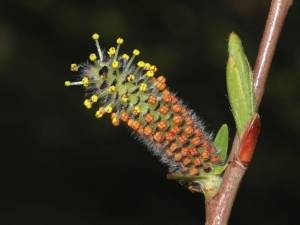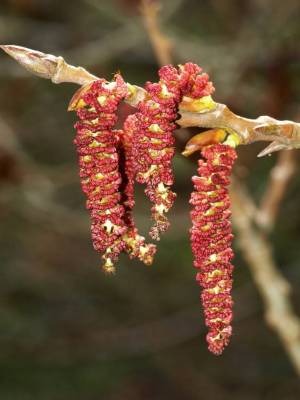Dr Phil Smith’s Wildlife Notes
March 2009
One of the harbingers of spring on the sand-dunes is the flowering of willows and poplars which have catkins. Most familiar are the “pussy” willows, both Grey (Salix cinerea) and Goat Willow (S. caprea) producing very similar furry catkins with golden stamens. However, these trees are unusual in having the sexes separate, so only the male bushes have the pussy catkins, the female flowers being a rather uninspiring greenish-yellow. As I have mentioned before, the Sefton Coast is exceptional in the variety of willows that grow here, some 29 different kinds having been identified. Many of these have distinctive catkins, arguably the most beautiful being those of the male Purple Willow (S. purpurea), though those of the non-native Violet Willow (S. daphnoides) and Siberian Violet-willow (S. acutifolia) are also very attractive and are sometimes grown in gardens.

We also have seven different types of poplar, which similarly produce distinctive catkins. Unexpectedly, most of these are of only one sex. Thus, the rather invasive Balsam Poplar (Populus x jackii), nowadays known as Balm-of-Gilead, produces only female catkins. This is the tree whose aromatic buds scent the air on calm spring days. In contrast, the equally common Grey Poplar (Populus x canescens) is almost always male, while one of its parents, White Poplar (P. alba), is mostly female. By the end of the month, the bright red male catkins of Black Poplar were beginning to appear on the 500 trees at Formby Point that were mapped last autumn. Usually, only male Black Poplars were planted because the females produce copious amounts of white fluffy seed which can be a nuisance.

March is also the month when bird-watchers eagerly await the return of familiar migrants from their southern winter-quarters. Wheatears arrived in a rush around the 17th, while the first Swallowand White Wagtail were seen at Marshside on 15th. Chiffchaffs were also singing from mid-month, the first Willow Warblers appearing on the last day of March. Probably as a result of climate change, our summer visitors now include that former rarity, the Avocet.
Birds turned up at Marshside in the second week, reaching 60 by 19th, the influx at Martin Mere being even more impressive, with 70 counted by the end of the month. One of the latter flock had been colour-ringed in Brittany in 2006, perhaps indicating a French origin for our Avocets. Less common migrants included Little Stint and Ring Ouzel at Marshside, Glaucous Gull at Birkdale and a spectacular Red Kite reported at Mere Brow on 16th. I was summoned to Seaforth on 21st to see a rare American Ring-necked Duck which, annoyingly, was later identified as a hybrid with the Tufted Duck! However, the same place turned up trumps ten days later with Iceland and Ring-billed Gulls, both from the other side of the Atlantic.
An interesting and useful publication is John Dempsey’s Wild Merseyside which sets out to describe the wealth of wildlife that we have in Merseyside and its surroundings. Beautifully illustrated, it provides very good value for money at £4.99 and is available in local bookshops.
